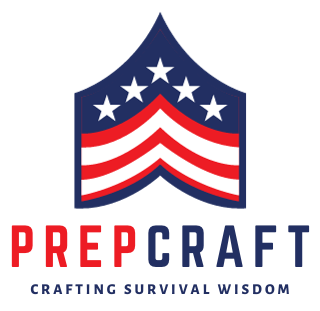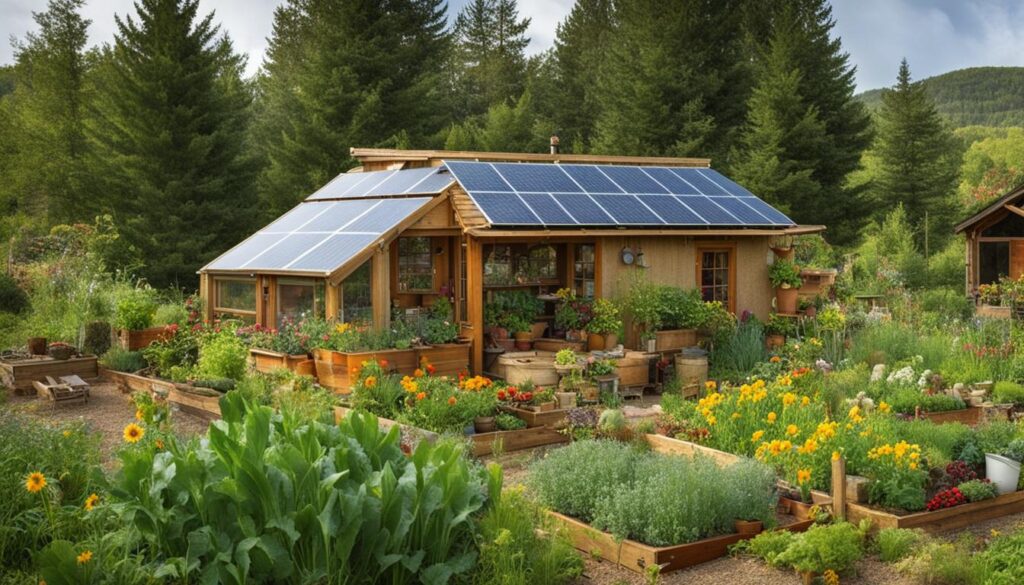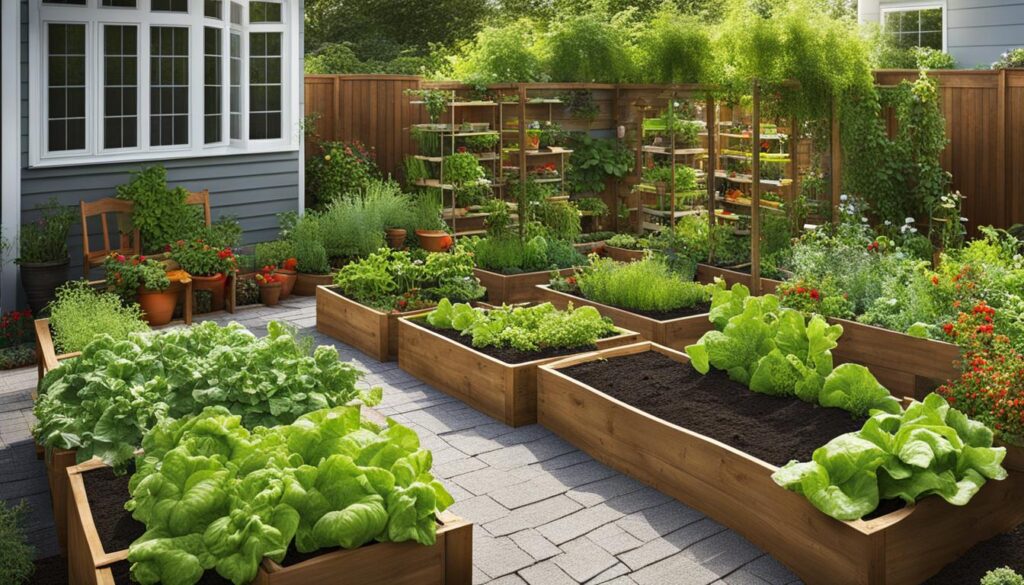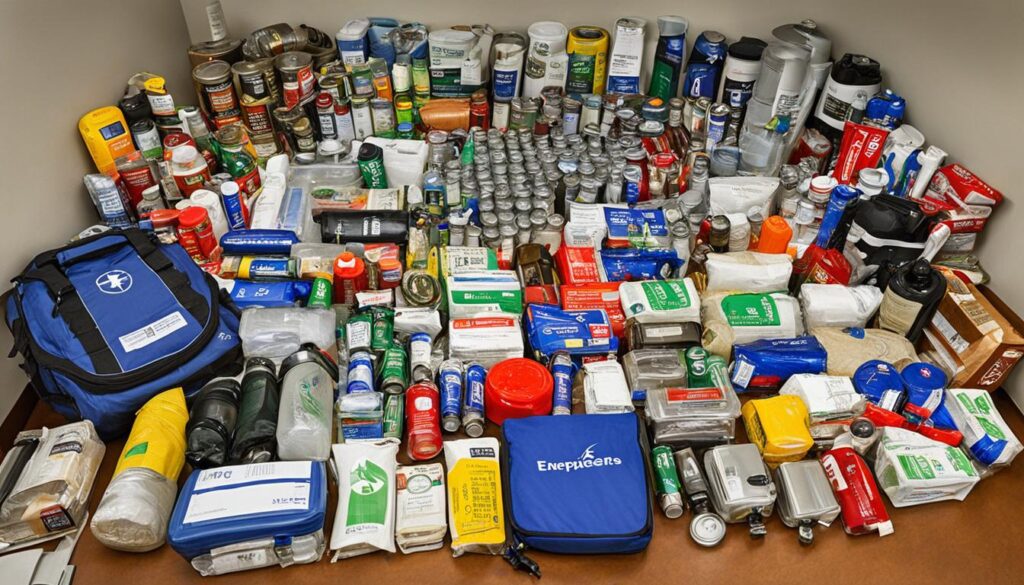
Emergencies can happen unexpectedly, leaving you without basic necessities like food, water, and electricity. That’s why having an emergency preparedness stockpile is important. In this article, I will discuss the key items you need to stockpile for self-reliance and peace of mind. I will provide a comprehensive guide on emergency preparedness, including tips on what to store, where to store it, and how to maintain your stockpile.
Key Takeaways:
- Emergency preparedness stockpiling is crucial for self-reliance during unexpected events.
- Ensure you have enough food, water, and other essential supplies in your stockpile.
- Proper storage and maintenance of your supplies are key to their effectiveness.
- Developing essential survival skills is essential for navigating emergencies confidently.
- Start building your emergency preparedness stockpile today to be ready for any situation.
The Importance of an Emergency Preparedness Stockpile
Having an emergency preparedness stockpile is crucial for ensuring your survival and comfort during uncertain times. Whether it’s a natural disaster, power outage, or a pandemic, being well-prepared can make a significant difference. The key to preparedness is having the necessary supplies in place to meet your basic needs when access to resources may be limited.
When building your emergency preparedness stockpile, it’s important to consider the specific needs and challenges that different types of emergencies may present. In the case of a natural disaster like a hurricane or earthquake, you may need to endure prolonged periods without electricity, water, or access to local stores. On the other hand, during a pandemic or other health crisis, you may face quarantine or restricted movement, which could limit your ability to procure essential items.
It’s essential to emphasize that while disaster preparedness is important, it does not mean living in constant fear or panic. Instead, it’s about taking proactive steps to safeguard yourself and your loved ones, giving you peace of mind knowing that you have the necessary provisions to weather any storm.
What Should Your Emergency Preparedness Stockpile Include?
Building the right emergency preparedness stockpile means having a well-rounded collection of supplies that can sustain you for an extended period. This includes:
- Emergency food storage: Non-perishable items with long shelf lives such as canned goods, dried fruits, and protein bars.
- Emergency water storage: Bottled water, water purification tablets, or a water filtration system.
- First aid kit: Basic medical supplies, including bandages, antiseptics, medications, and a comprehensive first aid manual.
- Emergency shelter: Tent, sleeping bags, blankets, and warm clothing to protect against extreme weather conditions.
- Lighting and communication: Flashlights, batteries, a portable radio, and a solar-powered charger for electronic devices.
- Personal hygiene items: Toilet paper, hand sanitizer, soap, and menstrual products.
- Essential tools: Swiss army knife, multi-purpose tool, and duct tape for various repair and utility needs.
These are just a few examples of the essentials you should consider including in your emergency preparedness stockpile. The specific items you choose may vary based on your location, climate, family size, and any unique needs or circumstances you may have. To ensure you have a comprehensive and well-rounded stockpile, consider creating a checklist and consulting reputable sources for further guidance.
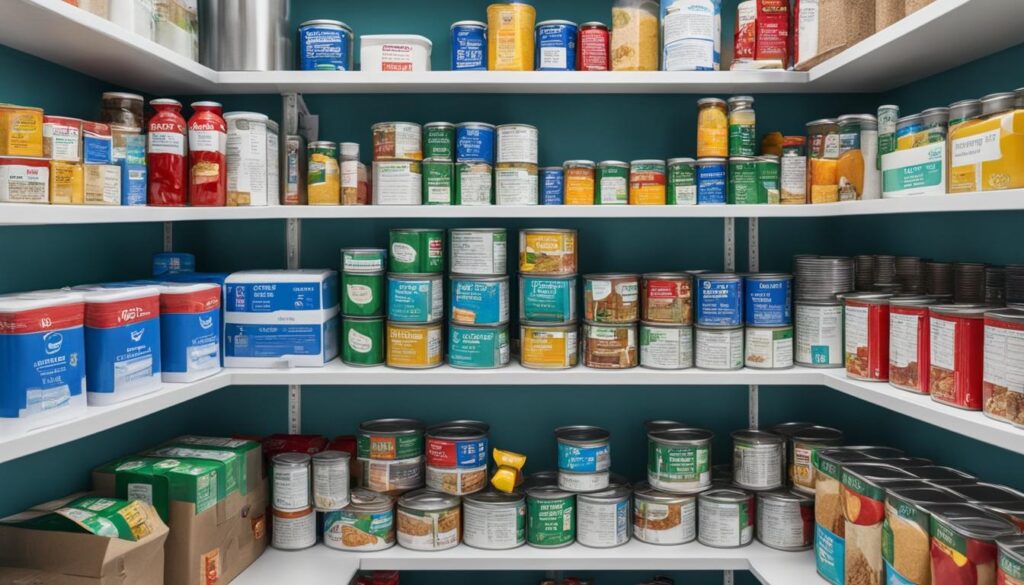
How Much Should You Store in Your Stockpile?
Determining how much to store in your emergency preparedness stockpile depends on several factors, such as the size of your household, the duration you want to be prepared for, and the availability of resources in your area. While it’s challenging to predict the exact quantity you may need, the general guideline is to stockpile enough supplies to sustain your household for at least three days to two weeks.
However, it’s essential to be adaptable and adjust your stockpile based on your specific circumstances and comfort level. If you live in a region prone to severe weather events or where access to resources may be limited, you may want to consider storing a more extended supply of essentials.
Remember to regularly check and rotate your stockpile to ensure freshness and effectiveness. Set reminders to review and update your supplies, especially when items are approaching their expiration dates.
Special Considerations for Disaster Preparedness
“In preparing for battle, I have always found that plans are useless, but planning is indispensable.” – Dwight D. Eisenhower
Disaster preparedness is not a one-size-fits-all approach. Each potential disaster brings its unique challenges, requiring specialized preparations. Here are a few examples:
| Emergency Survival Scenario | Special Considerations |
|---|---|
| Tornado | Designated safe area in your home, helmets for head protection, and emergency weather radio. |
| Flooding | Waterproof storage containers, sandbags to protect your home, and a plan for evacuation. |
| Pandemic | Extra stock of face masks, hand sanitizers, sanitizing wipes, and understanding quarantine protocols. |
Understanding the specific risks and requirements associated with each type of disaster will help you tailor your preparedness plans and stockpile to maximize your chances of survival and quick recovery.
In the next section, we will explore how to build an emergency preparedness stockpile on a budget, ensuring that you can be well-prepared without breaking the bank.
Building Your Emergency Preparedness Stockpile on a Budget
Building an emergency preparedness stockpile doesn’t have to break the bank. As we prioritize our safety and security, it’s essential to find ways to save money while ensuring we have the necessary supplies. In this section, I will provide you with practical tips and strategies for cheap stockpiling and preparedness supplies on a budget.
Finding Affordable Alternatives
When it comes to preparing for emergencies, there are often affordable alternatives to consider. Here are some ideas to help you save money while building your stockpile:
- Look for store brands or generic options: Many store brands offer reliable products at a lower price compared to well-known brands. Be open to trying these alternatives for non-perishable items.
- Consider DIY options: Sometimes, making certain items yourself can be a cost-effective alternative. For example, you can prepare homemade first aid kits or create your own emergency food rations.
- Borrow or trade with friends and neighbors: Community support plays a vital role in preparedness. Consider borrowing or trading supplies with friends, neighbors, or local community groups to expand your stockpile without spending extra money.
Buying in Bulk
Buying in bulk is a tried-and-tested method of saving money. By purchasing larger quantities, you can typically secure lower unit prices. Here are some tips for buying in bulk:
- Make a list and stick to it: Plan your purchases in advance to avoid impulsive buying. By creating a list of essential items, you can ensure that you buy only what you need.
- Compare prices: Before making bulk purchases, compare prices at different stores or online platforms. Look for discounts, promotions, or special deals that can help you save even more.
- Don’t forget about storage: Bulk purchases require adequate storage space. Ensure that you have enough room to store your supplies properly to prevent spoilage or damage.
Taking Advantage of Sales
Keep an eye out for sales and discounts to maximize your savings. Here are some ways you can take advantage of sales:
- Subscribe to newsletters: Sign up for newsletters from your favorite stores or online retailers to receive updates on upcoming sales and promotions. This way, you’ll always be informed and ready to make the most of the discounted prices.
- Shop off-season: Look for sales during off-seasons when emergency preparedness supplies might not be in high demand. You can often find significant discounts during these periods.
- Consider clearance items: Check the clearance sections of stores or online platforms for discounted items. While these products might be close to their expiration dates, they can still be useful and cost-effective for short-term emergencies.
Affordable Preparedness Supplies Checklist
To help you get started with your budget-friendly stockpiling, here’s an example of an affordable preparedness supplies checklist:
| Item | Quantity |
|---|---|
| Water bottles or purification tablets | 2 gallons per person per day |
| Canned food | At least a 3-day supply |
| Flashlights and batteries | At least 2 sets of batteries per flashlight |
| First aid kit | Basic supplies for minor injuries |
| Emergency blanket | 1 per person |
| Manual can opener | 1 |
Remember, this is just a starting point. Customize your stockpile based on your family’s needs and preferences.
By following these budget-conscious strategies and using the tips mentioned above, you can build a comprehensive emergency preparedness stockpile without compromising on quality or safety. Preparing for emergencies doesn’t have to be expensive; it’s about being resourceful and planning ahead.

Continue to Section 4: Assessing Risks and Developing Your Preparedness Plan
Assessing Risks and Developing Your Preparedness Plan
When it comes to emergency preparedness, assessing the risks specific to your location and circumstances is crucial. By understanding the potential threats you may face, you can develop a personalized preparedness plan that addresses your unique needs. In this section, I will guide you through the process of assessing risks and creating a comprehensive emergency preparedness plan.
Identifying Potential Threats
One of the first steps in developing your preparedness plan is identifying the potential threats you may encounter. Consider the following factors:
- The geographical location of your area
- Historical data on past emergencies in your region
- Weather patterns and climate conditions
- Local infrastructure vulnerabilities
- Social and political factors that may affect your safety
By taking these factors into account, you can gain insights into the most probable emergency scenarios you may face.
Prioritizing Scenarios
Once you have identified potential threats, it’s important to prioritize the scenarios based on their likelihood and impact. Consider the following questions:
- Which emergencies are more likely to occur in your area?
- What are the potential consequences of each scenario?
- Which scenarios pose the highest risk to your safety and well-being?
By prioritizing scenarios, you can allocate your resources and efforts effectively to address the most critical emergencies.
Creating Your Emergency Preparedness Plan
With a clear understanding of the potential threats and their priorities, it’s time to develop your emergency preparedness plan. Your plan should cover the following aspects:
- Emergency Kit: Compile an emergency kit with essential supplies that can sustain you and your family for at least 72 hours.
- Emergency Contacts: Create a list of emergency contacts, including local authorities, medical facilities, and neighbors who can provide assistance.
- Communication Plan: Establish a communication plan with your family members, including a meeting point and alternative methods of communication in case of disrupted services.
- Evacuation Routes: Identify primary and secondary evacuation routes from your home and designate meeting points outside your neighborhood.
- Special Considerations: Take into account any specific needs or requirements of family members, such as medications, medical equipment, or dietary restrictions.
Remember to regularly review and update your emergency preparedness plan based on changing circumstances or new information.
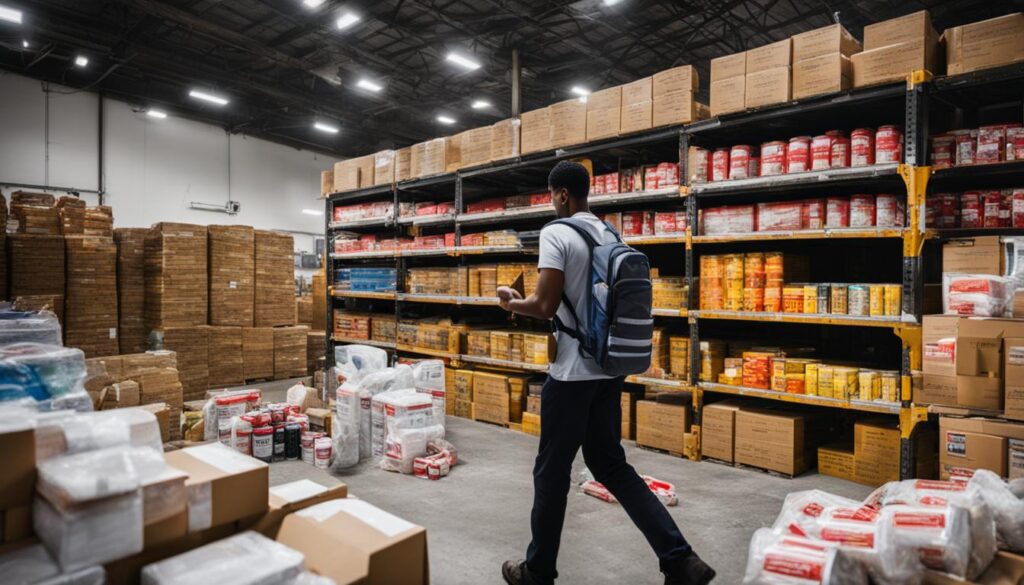
By assessing risks and developing a personalized preparedness plan, you can ensure that you are well-prepared for any situation. In the next section, we will discuss the importance of proper storage and maintenance of your emergency supplies.
Storing and Maintaining Your Emergency Supplies
Proper storage and maintenance of your emergency supplies are essential to ensure their effectiveness when you need them most. In this section, I will provide you with guidelines on how to store your food, water, and other essential supplies. We will discuss the best storage containers and locations, as well as share tips to prevent damage from pests and other threats. Additionally, I will cover how to regularly check and rotate your supplies to maintain their quality and safety.
Storing Emergency Supplies
When it comes to storing your emergency supplies, it’s important to choose the right containers and locations. Here are some key considerations:
- Food Storage: Store dry goods, such as rice, pasta, and canned goods, in a cool, dry place away from sunlight. Use airtight containers or resealable bags to protect against moisture and pests.
- Water Storage: Store water in food-grade containers specifically designed for long-term storage. These containers should be clean and sanitized before filling with water. Store them in a cool, dark place to prevent bacterial growth.
- Other Essential Supplies: Store items like batteries, flashlights, and first aid kits in a designated emergency supplies area. Keep them easily accessible and organized so you can quickly grab them in case of an emergency.
Maintaining Your Emergency Supplies
Maintaining your emergency supplies is crucial to ensure they remain safe and usable over time. Here are some tips:
- Regularly Check Expiration Dates: Pay attention to the expiration dates of food items and replace them as necessary. Rotate your stock by using the oldest items first and restocking with fresh supplies.
- Inspect for Damage: Regularly inspect your containers for signs of damage, such as cracks or leaks. Replace any damaged containers to prevent spoilage or contamination.
- Protect Against Pests: Store your supplies in pest-resistant containers and regularly clean the storage area to prevent insects or rodents from accessing your stockpile.
- Review and Update: Periodically review your emergency supplies to ensure they meet your current needs. Update your stockpile based on any changes to your family size, dietary restrictions, or specific emergency requirements.
By following these guidelines for storing and maintaining your emergency supplies, you can be confident that you are prepared for any unexpected situation that may arise.
Note: Image above depicts safe food and water storage practices, ensuring the long-term viability of your emergency supplies.
Learning Essential Survival Skills
In addition to having the right supplies, learning essential survival skills is crucial for self-reliance during emergencies. Developing these skills can make a significant difference in your ability to navigate challenging situations and increase your chances of survival. In this section, we will explore the core survival skills you should focus on: first aid, fire-starting, shelter-building, and water purification.
First Aid
Having basic knowledge of first aid can be lifesaving in emergency situations. You should learn how to administer CPR, stop bleeding, dress wounds, and treat burns. Understanding how to identify and provide initial care for common injuries and medical emergencies is essential. Taking a first aid course or obtaining a certification from organizations like the American Red Cross can equip you with the necessary skills.
Fire-Starting
Being able to start a fire is essential for various purposes, including warmth, cooking, and signaling for help. Learning different fire-starting techniques, such as using matches, lighters, fire starters, or natural materials like flint and steel, will ensure you can create a fire in different situations. It’s crucial to understand fire safety measures and how to properly extinguish a fire to prevent accidents.
Shelter-Building
Building a shelter in the wild can provide protection from the elements and improve your chances of survival. You should learn how to construct various types of shelters, such as debris shelters, lean-tos, and improvised tents. Understanding how to choose a suitable location, gather materials, and secure your shelter will ensure your comfort and safety in different environments.
Water Purification
Access to clean drinking water is vital for survival. Learning different water purification methods, such as boiling, using water filters, chemical purification, and solar disinfection, will enable you to make contaminated water safe to drink. Understanding how to identify potential water sources, collect water, and apply the appropriate purification techniques can prevent waterborne illnesses and dehydration.
Continuous learning and practice are key to mastering these survival skills. There are various resources available to acquire and hone these skills, including online tutorials, books, workshops, and outdoor survival courses. Remember, the more you practice, the more confident and capable you will become in navigating emergencies.
“Learning survival skills is not just about theoretical knowledge; it’s about hands-on practice and building confidence in your abilities.”
| Skill | Description |
|---|---|
| First Aid | Basic medical care and initial treatment for injuries and medical emergencies. |
| Fire-Starting | Techniques and methods to start a fire for warmth, cooking, and signaling. |
| Shelter-Building | Constructing shelters for protection from the elements and improving comfort. |
| Water Purification | Methods to make contaminated water safe for drinking. |
Conclusion
In conclusion, emergency preparedness is essential for achieving self-reliance and maintaining peace of mind. By creating a well-stocked and well-planned emergency preparedness stockpile, you can ensure your survival and comfort during uncertain times. Whether it’s a natural disaster, power outage, or any other emergency situation, being prepared is crucial.
To start, assess the risks specific to your location and circumstances. Develop a personalized emergency preparedness plan that covers all possible scenarios. This plan will serve as your guide in building the necessary supplies and acquiring the essential skills for self-reliance.
Stockpiling essentials such as food, water, and medical supplies should be a priority. Store these items properly in suitable containers and locations to maintain their quality and effectiveness. Regularly check and rotate your supplies to ensure freshness and safety. Additionally, invest time in learning survival skills like first aid, fire-starting, shelter-building, and water purification. These skills will further enhance your ability to navigate emergencies successfully.
Remember, emergency preparedness is an ongoing process. Start today by building your emergency preparedness stockpile and gaining the necessary skills. With a well-prepared plan and the right supplies, you can embark on your journey towards self-reliance and be ready to face any challenges that come your way.
FAQ
Why is having an emergency preparedness stockpile important?
An emergency preparedness stockpile is crucial for ensuring your survival and comfort during uncertain times. It provides you with the basic necessities like food, water, and other essential supplies when they may not be readily available.
What items should be included in an emergency preparedness stockpile?
Some essential items to include in your emergency stockpile are non-perishable food, water, a first aid kit, flashlight and batteries, a multi-tool, extra medications, and personal hygiene items. You should also consider specific needs like baby supplies, pet food, and important documents.
How much should I store in my emergency preparedness stockpile?
It is generally recommended to have at least a two-week supply of food and water for each person in your household. However, your specific needs may vary based on factors such as family size, dietary restrictions, and any unique circumstances.
How can I build an emergency preparedness stockpile on a budget?
Building a stockpile on a budget is possible by buying in bulk, taking advantage of sales and discounts, and finding affordable alternatives. You can also gradually build your stockpile over time by prioritizing the most essential items first.
How do I assess the risks and develop a personalized preparedness plan?
Start by identifying potential threats based on your location and circumstances. Research local hazards like natural disasters and consider personal factors such as health conditions and mobility. Then, prioritize scenarios and create a detailed plan that covers communication, shelter, evacuation routes, and meeting points.
How should I store and maintain my emergency supplies?
It is important to store your emergency supplies in a cool, dry, and dark location. Use sturdy, airtight containers to protect against pests and moisture. Regularly check expiration dates and rotate your supplies to ensure they remain fresh and effective.
What survival skills should I learn for emergencies?
Essential survival skills include first aid, fire-starting, shelter-building, and water purification. Learning these skills can significantly increase your chances of survival and self-reliance during emergencies. Take advantage of resources like first aid courses, survival training, and online tutorials to acquire and practice these skills.
